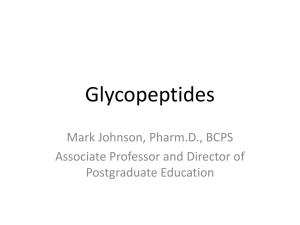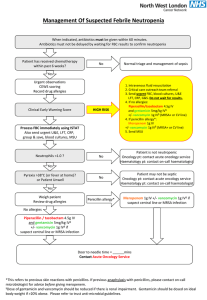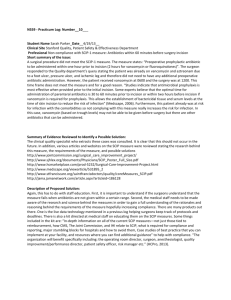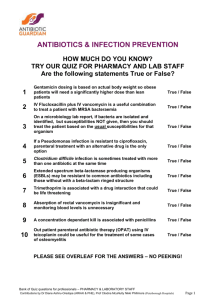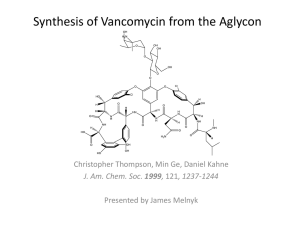Vancomycin Actavis, capsule hard ENG
advertisement
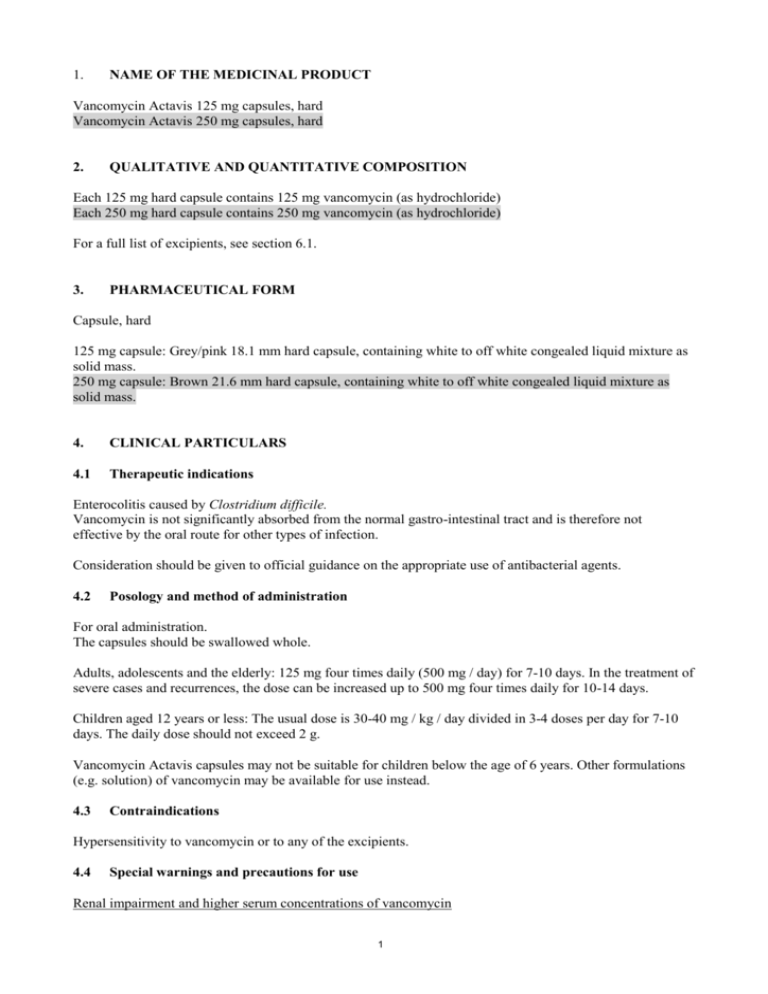
1.
NAME OF THE MEDICINAL PRODUCT
Vancomycin Actavis 125 mg capsules, hard
Vancomycin Actavis 250 mg capsules, hard
2.
QUALITATIVE AND QUANTITATIVE COMPOSITION
Each 125 mg hard capsule contains 125 mg vancomycin (as hydrochloride)
Each 250 mg hard capsule contains 250 mg vancomycin (as hydrochloride)
For a full list of excipients, see section 6.1.
3.
PHARMACEUTICAL FORM
Capsule, hard
125 mg capsule: Grey/pink 18.1 mm hard capsule, containing white to off white congealed liquid mixture as
solid mass.
250 mg capsule: Brown 21.6 mm hard capsule, containing white to off white congealed liquid mixture as
solid mass.
4.
CLINICAL PARTICULARS
4.1
Therapeutic indications
Enterocolitis caused by Clostridium difficile.
Vancomycin is not significantly absorbed from the normal gastro-intestinal tract and is therefore not
effective by the oral route for other types of infection.
Consideration should be given to official guidance on the appropriate use of antibacterial agents.
4.2
Posology and method of administration
For oral administration.
The capsules should be swallowed whole.
Adults, adolescents and the elderly: 125 mg four times daily (500 mg / day) for 7-10 days. In the treatment of
severe cases and recurrences, the dose can be increased up to 500 mg four times daily for 10-14 days.
Children aged 12 years or less: The usual dose is 30-40 mg / kg / day divided in 3-4 doses per day for 7-10
days. The daily dose should not exceed 2 g.
Vancomycin Actavis capsules may not be suitable for children below the age of 6 years. Other formulations
(e.g. solution) of vancomycin may be available for use instead.
4.3
Contraindications
Hypersensitivity to vancomycin or to any of the excipients.
4.4
Special warnings and precautions for use
Renal impairment and higher serum concentrations of vancomycin
1
In some patients with severe renal impairment and severe colitis, significant serum concentrations have been
measured after repeated dosing. Thus, there is a risk for side effects that are normally only seen after
parenteral administration in these patients.
Clinically significant serum concentrations have been reported in some patients who have taken multiple oral
doses of vancomycin for active Clostridium difficile-induced pseudomembranous colitis. Therefore,
monitoring of serum concentrations may be appropriate in these patients. The risk may be increased in
patients with impaired renal function.
Some patients with inflammatory disorders of the intestinal mucosa may have significant systemic
absorption of vancomycin and, therefore, may be at risk for the development of adverse reactions associated
with the parenteral administration of vancomycin. The risk is greater in patients with renal impairment. It
should be noted that the total systemic and renal clearances of vancomycin are reduced in the elderly.
Ototoxicity
Ototoxicity has occurred in patients receiving vancomycin. It may be transient or permanent. It has been
reported mostly in patients who have been given excessive intravenous doses, have an underlying hearing
loss, or are receiving concomitant therapy with an ototoxic agent such as an aminoglycoside.
Infection
Prolonged use of vancomycin may result in the overgrowth of non-susceptible organisms including fungi.
Careful observation of the patient is essential. If superinfection occurs during therapy, appropriate measures
should be taken.
4.5
Interaction with other medicinal products and other forms of interaction
No interactions have been reported for orally administered vancomycin. In patients with severe renal
impairment and severe colitis systemic absorption may occur resulting in a risk for interactions that are
normally only seen after parenteral administration. For example, parenteral administration of vancomycin
and anesthetics may cause erythema and anaphylactic reactions.
Some antibiotics were rarely reported to reduce the effect of oral contraceptives by interfering with the
bacterial hydrolysis of conjugated steroids in the intestine and thus reabsorption of unconjugated steroid.
This would lower the plasma levels of active steroid. This unusual interaction would occur in women with
high excretion of conjugated steroids in bile.
Concurrent and/or sequential systemic or topical use of other potentially ototoxic and/or nephrotoxic drugs
requires careful monitoring.
4.6
Fertility, pregnancy and lactation
Pregnancy: The safe use of vancomycin during pregnancy has not been established. Reproductive studies in
animals at doses roughly equivalent to the clinical dose based on body surface area (mg/m2), do not indicate
any direct or indirect effects on embryonic development, foetus or gestation. Vancomycin should be used
during pregnancy only if the benefit outweighs the potential risk.
Breastfeeding: Vancomycin is excreted in human milk. In view of the drug's impact on the nursing mother it
should be decided to stop breast-feeding or discontinue treatment.
Fertility: No definitive fertility studies have been conducted.
4.7
Effects on ability to drive and use machines
Vertigo and dizziness have been reported rarely, and may affect the ability to drive and to use machines.
4.8
Undesirable effects
2
Since vancomycin is normally absorbed only to a limited extent, the risk of systemic toxicity is low.
The following adverse reactions are listed according to MedDRA system organ class and frequency category.
Frequency categories are defined using the following convention: very common (≥1/10); common (≥1/100 to
<1/10); uncommon (≥1/1,000 to <1/100); rare (≥1/10,000 to <1/1,000); very rare (<1/10,000); not known
(cannot be estimated from the available data).
Blood and lymphatic system disorders:
Rare: Leukopenia, thrombocytopenia, eosinophilia, reversible agranulocytosis.
Immune system disorders
Not known: Drug rash with eosinophilia and systemic symptoms (DRESS syndrome) has been reported
during postmarketing experience.
Ear and labyrinth disorders:
Uncommon: Hearing loss.
Rare: Tinnitus.
Cardiac disorders:
Very rare: Cardiac arrest
Vascular disorders:
Rare: Hypotension, vasculitis.
Respiratory, thoracic and mediastinal disorders:
Rare: Shortness of breath, stridor.
Gastrointestinal disorders:
Uncommon: Nausea.
Very rare: Pseudomembranous enterocolitis.
Skin and subcutaneous tissue disorders:
Uncommon: Rash, pruritus
Rare: Redness on the upper body, urticaria, Stevens-Johnson syndrome, toxic epidermal necrolysis, IgA
induced bullous dermatitis.
Musculoskeletal and connective tissue disorders:
Rare: Muscle cramps and pains in the chest and back.
Renal and urinary disorders:
Rare: Renal failure, elevated serum creatinine, interstitial nephritis.
General disorders and administration site conditions:
Uncommon: Fever.
Rare: Anaphylactic reactions, chills, dizziness.
Elevated serum creatinine as a sign of renal involvement have been reported mainly for intravenous
vancomycin. A few cases of interstitial nephritis have been reported, mostly associated with concomitant use
of aminoglycosides or for patients with previously impaired renal function. Renal side effects are reversible.
Hearing loss has been reported in a dozen cases with intravenous vancomycin, most associated with renal
impairment or previous hearing loss, or concomitant treatment with ototoxic drugs. Reversible neutropenia,
after about a week of intravenous vancomycin therapy or total dose of 25 g, have been reported in few cases.
Isolated cases of agranulocytosis have been reported, but the relationship to vancomycin has not been
verified.
3
4.9
Overdose
Toxicity: Limited experience in overdose, however, 500 mg IV given to a 2-year-old lead to lethal
intoxication. 56 g spread over 10 days to an adult caused renal insufficiency.
Symptoms: Overdose may cause nausea, vomiting, epigastric discomfort and diarrhoea. Possible symptoms
that have been reported as side effects (see section 4.8) are reinforced in overdose. Possible renal symptoms.
Treatment: Gastric lavage, charcoal in repeated doses (reducing half-life). Ensure adequate diuresis.
Hemodialysis or hemoperfusion can be used when toxic symptoms and concomitant renal insuffiviency
occur. Symptomatic treatment.
5.
PHARMACOLOGICAL PROPERTIES
5.1
Pharmacodynamic properties
ATC classification
Pharmacotherapeutic group: intestinal antiinfectives, antibiotics, ATC code: A07AA09
Mode of action
Vancomycin is a tricyclic glycopeptide antibiotic that inhibits the syntesis of the cell wall in sensitive
bacteria by binding with high affinity to the D-alanyl-D-alanine terminus of cell wall precursor units. In
addition, it impairs the permeability of the bacterial cell membrane and RNA synthesis.
PK/PD relationship
Vancomycin activity is considered to be time-dependent.
Mechanism(s) of resistance
Acquired resistance to glycopeptides is most common in enterococci and is based on acquisition of various
van gene complexes which modifies the D-alanyl-D-alanine target to D-alanyl-D-lactate or D-alanyl-Dserine which bind vancomycin poorly. In some countries, increasing cases of resistance are observed in
enterococci; multi-resistant strains of Enterococcus faecium are especially alarming.
Van genes have rarely been found in Staphylococcus aureus, where changes in cell wall structure result in
“intermediate” susceptibility, which is most commonly heterogeneous.
There is no cross-resistance between vancomycin and other antibiotics but cross-resistance with other
glycopeptide antibiotics, such as teicoplanin, does occur. Secondary development of resistance during
therapy is rare.
Orally administered vancomycin is active against Clostridium difficile
Susceptibility
The prevalence of acquired resistance may vary geographically and with time for selected species and local
information on resistance is desirable, particularly when treating severe infections. As necessary, expert
advice should be sought when the local prevalence of resistance is such that the utility of the agent in at least
some types of infections is questionable.
Commonly susceptible species
Clostridium difficile
4
5.2
Pharmacokinetic properties
After oral administration of vancomycin in healthy volunteers and patients with inflammatory bowel disease
and normal renal function, absorption is low. With repeated dosing of 125 mg every 6 hours faecal
concentration exceeds 100 mg / kg in the majority of samples. No vancomycin was detectable in the blood
and urinary recovery was less than 1%.
Measurable serum concentrations may occur infrequently in patients with active C. difficile-induced
pseudomembranous colitis and, in the presence of renal impairment, there is a risk of accumulation.
Administration of vancomycin oral solution, 2 g daily for 16 days to anephric patients with no inflammatory
bowel disease, gave measurable serum levels of >0.66 μg/ml in 2 out of 5 patients. With doses of 2 g daily,
concentrations of >3,100 mg/kg were found in the faeces and levels of <1 μg/ml were found in the serum of
patients with normal renal function who had pseudomembranous colitis.
Following parenteral administration vancomycin is excreted renally, nearly completely as the
microbiologically active substance. The serum half life in adult patients with normal renal function has been
reported to be about 4-6 hours, in children 2.2-3 hours. Impaired renal function can prolong the elimination
(up to 7.5 days).
5.3
Preclinical safety data
Non-clinical data reveal no special hazard for humans based on conventional studies of safety pharmacology
and repeated dose toxicity.
Limited data on mutagenic effects show negative results, long-term studies in animals regarding a
carcinogenic potential are not available. In teratogenicity studies, where rats and rabbits received doses
approximately corresponding to the human dose based on body surface (mg/m2), no direct or indirect
teratogenic effects were observed.
Animal studies of the use during the perinatal/postnatal period and regarding effects on fertility are not
available.
6.
PHARMACEUTICAL PARTICULARS
6.1
List of excipients
Capsule content
Macrogol 6000
Capsule cap and body
Titanium Dioxide (E 171)
Iron oxide black (E 172)
Iron oxide red (E 172)
Iron oxide yellow (E 172)
Gelatin
6.2
Incompatibilities
Not applicable.
6.3
Shelf life
2 years
6.4
Special precautions for storage
5
Do not store above 25°C
6.5
Nature and contents of container
PVC/PE/ACLAR/aluminium blister packs
28 and 30 capsules
Not all pack sizes may be marketed.
6.6
Special precautions for disposal
No special requirements
Any unused product or waste material should be disposed of in accordance with local requirements.
7.
MARKETING AUTHORISATION HOLDER
<[To be completed nationally]>
{Name and address}
<{tel}>
<{fax}>
<{e-mail}>
8.
MARKETING AUTHORISATION NUMBER(S)
<[To be completed nationally]>
9.
DATE OF FIRST AUTHORISATION/RENEWAL OF THE AUTHORISATION
<{DD/MM/YYYY}> <{DD month YYYY}>
<[To be completed nationally]>
10.
DATE OF REVISION OF THE TEXT
2013-01-04
6
